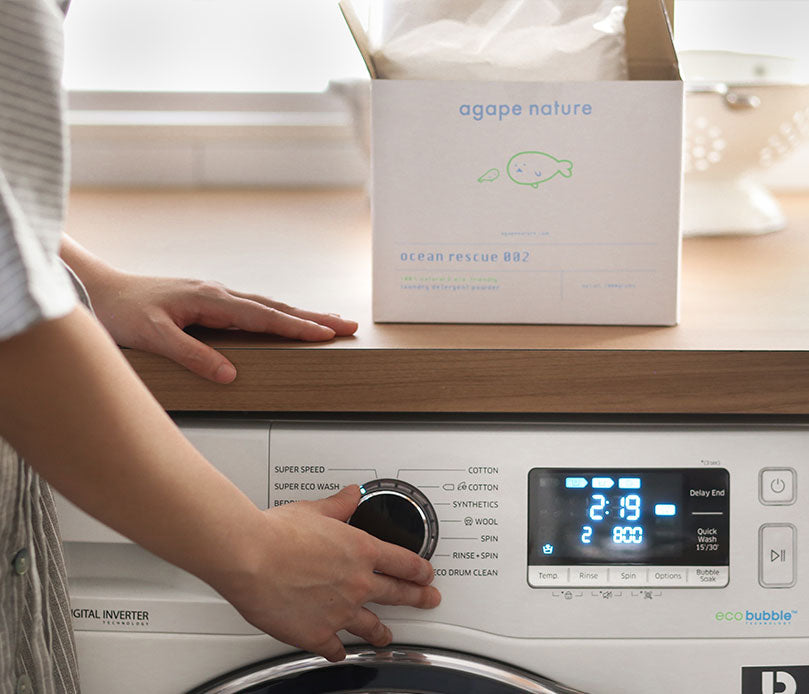One of the secrets to making your clothes last longer is knowing how to take care of them. Most of our garment’s wear and tear comes from regular washing, which can take a toll on your favorite items and investment pieces.
Laundry may seem like an intimidating chore, but there are just a few simple things to keep in mind - we promise it gets easier over time!
Below, we share some easy tips on how to care for your garments, so you’ll be looking forward to your next laundry day when it comes around.
The first thing to check before placing an item in the laundry basket is whether it really needs to be washed. Most of us are guilty of over-washing our garments when they would be fine with a freshen-up instead. Over-washing is the main reason a wardrobe favorite might fade, shrink, or lose its shape.
Top tip from our community members: If a garment needs to be refreshed, it can be hung outside or in a steamy bathroom, or deodorized with a hand-held steamer.
Pre-washing
1. Check the care labels

Different materials require different care, so you should always check the care label before washing your garments. To reduce our use of packaging and wastage, we’ve put detailed washing instructions for each product on our website, so you can always check back if you’re unsure about how to wash your clothes.
The temperature given on a care label is usually the maximum temperature an item can be washed at, not the recommended temperature. Washing below the maximum temperature reduces the risk of shrinking or fading clothes, whilst keeping your garments just as clean. The only exception to this is items that come into close contact with your skin, for example underwear, which usually require a higher temperature to remove bacteria.

Rachel wears the Relaxed Jumpsuit.
A good old-fashioned sorting session is the best way to avoid whites from becoming discoloured. White pieces should never be mixed with colours. You should also separate out the more delicate items, such as blouses, from those that should be washed at a higher heat, like bedding. Additionally, separating soiled clothing from less dirty clothing prevents transfer of dirt from one item to another.3. Prepare your clothes for the washing machine

Garments made from cotton like the Organic Cotton Crop Overlap Top, can be placed in the washing machine on a delicate cycle.
Turn your clothes inside out and close all zips and fastenings to avoid friction and minimize abrasions on your clothing when placing them in the washing machine. For more delicate items, you can also prevent friction by investing in a mesh laundry bag or a GuppyFriend bag. Over or underfilling the washing machine can cause damage to garments too. Make sure to check the maximum load for your washing machine. A rule of thumb is to fill your washing machine till it is three-quarters full.
Washing
Opt for washing powders for your whites

A 100% natural and eco-friendly laundry powder like agape nature's Ocean Rescue 002 laundry detergent powder is less harsh on your garments and the environment.
Washing powder is more likely to remove the dirt that is making your whites appear grey or dull. Also, using more washing powder does not necessarily mean cleaner clothes. In fact, excess detergent left on your clothing can attract dirt. If you feel like your washing powder needs an extra boost, use one with optical brighteners or try adding half a cup of bicarbonate of soda to your next washing load of whites.
2. The best temperature for your whites
For white clothes, it’s best to use the warmest water recommended for the fabric. Higher temperatures are more likely to remove grime, cosmetics and body oils, although it is imperative to make sure that all surface stains are removed before washing, as hot water can actually set the stain.
3. Cold and quick for your darks
It’s best to sort and wash similar shades together on the shortest cold-water cycle possible to minimise fading and preserve their colour, as hot water can cause the fabric to loosen and release its dye. If you are concerned about the color running, do a test with warm water in a sink before placing the item in a washing machine. If it bleeds, it’s recommended to hand wash the garment. Cotton and denim are the biggest culprits for releasing dye, so always check these before their first wash.
4. Be careful with detergent when it comes to your darks
Detergents work best with dark clothes instead of washing powder, as undissolved particles from the powder can cling to the item and leave white streaks. Use a detergent formulated for dark colors or use the smallest amount of your regular detergent as possible. As with white clothes, excessive amounts of detergent can leave a residue that makes fabrics appear faded, as well as encouraging dye bleeding.
5. Duration is key for coloured clothes
Select the coldest and shortest cycle possible to preserve the colour on your coloured clothes. Although brightly coloured pieces often shed a little dye over time, reducing the temperatures that they are exposed to will slow down this process.
6. It’s all about prevention
Wash brand new pieces on their own for the first few washes. This is when they are most likely to be shedding dye and this will also lower the risk of the colors bleeding onto your other clothes.
7. Synthetic Clothing
The Guppyfriend Washing Bag prevents microplastics shed from synthetic garments from ending up in the waterways.
Microplastic released from washing harms the environment. With each wash, countless microfibres from synthetic textiles make their way from washing machines into rivers, lakes, and oceans. Once in the environment, the microfibres are consumed by aquatic organisms, which can result in gastrointestinal infections and blockages, reproductive problems, and starvation. The tiny plastic fragments threaten our own health: as they enter our food and our bodies through the food chain.
The Guppyfriend Washing Bag protects garments and filters microplastic fibers from synthetic textiles, preventing microplastics from entering nature. To help reduce the release of microplastic fibers into our waterways, place your clothing made from synthetic textiles into the Guppyfriend Washing bag, and separate textiles with a hard surface from those with a soft surface.
Drying your clothes
1. Line-drying your clothes

Rachel wears the Down to a Tee and a Fable Living Apron.
Another way to reduce clothing damage is to air dry it. Even on a gentle setting, dryers are likely to cause more wear and tear compared to line drying. Substitute your dryer for a washing line or drying rack instead. Delicate items such as jumpers, underwear or any clothing with stretch may need to be dried flat, so make sure to check their labels.
2. Drying your whites
3. Drying your coloured or dark clothing
Your dark clothing conversely, dries better under shade, in an area out of direct sunlight. It’s best to keep your dark clothing flipped inside out, as UV rays will fade the color.
Hand-washing your clothes
Not every piece of clothing can be thrown into your washing machine. Follow these simple instructions for delicate items or clothing labels with a "hand wash" symbol.
1. Fill a tub with water

A gentle stain remover like agape nature's Love Rescue 001 stain remover not only removes stains on fabric, but is made from organic ingredients.
Fill a tub or sink with water at the temperature recommended on the care label. If no label exists, choose cool to lukewarm water. Add about a teaspoon of detergent. You may need more detergent if you are hand-washing a large item or multiple items.

Submerge the garment in the soapy water and soak. Use gentle movements to swish the item through the water. Avoid rubbing, scrubbing or twisting actions that can stretch or damage the fabric. Gently swish the garment through the soapy water until the item is clean.
3. Rinse and repeat
Drain the sink or tub, and refill it with cool rinse water. Push the garment up and down in the water until all soap is removed. If you're unsure, sniff the garment to make sure it is no longer scented. Repeat the process with clean water if necessary.
Caring for more delicate fabrics like Tencel and Cupro
Our range of Tencel and Cupro fabrics have been sandwashed during the production process to produce clothing that is soft to the touch. This natural method of finishing the fabrics helps to create a similar handfeel to silk, but also makes them extra delicate. This is why we always recommend dry-cleaning. However, we have included some tips on how to care for your Tencel and Cupro garments if you prefer to hand wash them.
1. Hand wash lightly
Follow our steps above to hand wash your garments. To remove any detergent residue, gently swirl your garment around in the water again for approximately one minute, ensuring that no soap is left. Repeat the process if necessary.
After washing, be careful not to squeeze the water out. Instead, drain the soapy water from the bowl and refill it with some more cool, clean water.
2. Drying your Tencel and Cupro garment
Tencel and Cupro should be air dried for the best results. First, absorb any excess moisture by laying it out flat on top of a clean towel. Roll the towel up with the garment inside, and gently press down. Repeat the process with another clean towel until the garment is no longer soaking.
Alternatively, let the garment drip dry in your bathroom or drying area.
It is important to lay the garment out flat on a drying rack without using any clothes pegs and smoothen out any creases as the fabric will chafe easily, developing white lines due to colour being rubbed off at folds and creases. The garment should also be dried in the shade, as direct sunlight can cause its colours to fade.
Here’s to caring for our treasured pieces and making them last longer. To make laundry day more relaxing for you, check out our Laundry Day Spotify playlist here.
Special thanks to Monica Lie for photography, Rachel Leong for being a part of this photoshoot and Rosalind Kang for opening up her home to us.
Featuring GuppyFriend Laundry Bags, agape nature's Love Rescue 001 stain remover and Ocean Rescue 002 washing powder, and Fable Living aprons.

